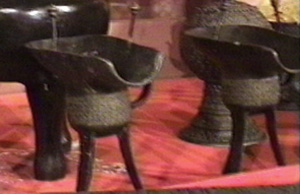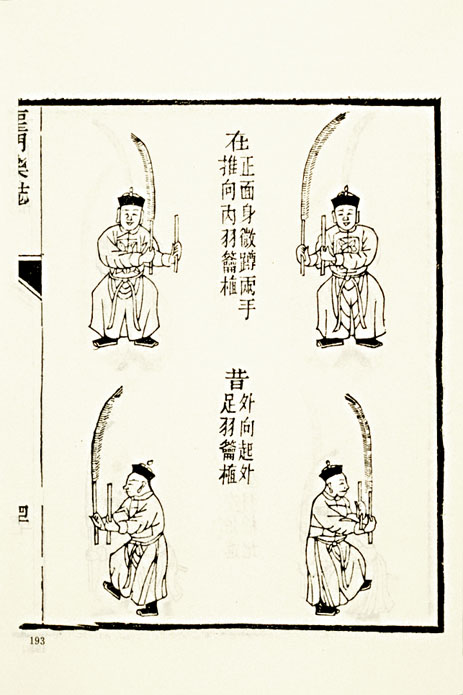

The Ordering Hymn plays in the background. Similar to the first offering, the primary consecration officer bows to the altar and offers up silk and wine. To finish the second offering, he bows three times. Accompanying the final offering is the Enunciation Dance and Hymn.
The Ordering Hymn
Perform the rite without err;
Ascend the Hall for the second offering
Drums and bells sound in accord;
Genuine, the wine cauldron
Sincere, the food pots
Solemn novices,
Majestic scholars
The rites correct us, the music refines us;
Made virtuous are we who observe this rite
Wine, Silk, and Animals

The wine goblets/tripods used in this ceremony
In imperial China, the status of the spirit dictated what level of sacrifice should be used. The Autumnal Sacrifice to Confucius features the large beast sacrifice, or san sheng. The use of the large beast sacrifice, which consists of offering an ox, goat, and pig, signifies Kongzi's high rank in the spiritual pantheon. Traditionally, each of the correlates was offered a small beast sacrifice of a goat and pig, while the savants shared a pig. The remaining spirits--the scholars and worthies--shared a pig.
In addition to the animal sacrifices, all spirits were presented with varying amounts of wine; Kongzi receives several tripods of wine, while the worthies and scholars shared three goblets of wine.
Silk damasks were used in the ritual offerings. Before the use of coinage and later paper currency, silk was the standard of exchange among the living. Accordingly, silk was offered up as currency for spirits to use in the afterlife.
Enunciation Dance and Hymn
From antiquity in days of yore,
The earliest people rise up
In deerskin caps they offered food
Dances

While music was considered to be the sonic embodiment of the ritual, so too were the dances understood as choreographic embodiments of the ritual. During the ritual, three dances are performed to accompany the six hymns. Each of the dances was carefully choreographed to properly correspond to the music. Dancers all held a pheasant feather and a reed pipe, which they utilized in their complex and deliberate dances. Just as each hymn was composed according to strict regulations, each dance consisted of ninety-six standardized postures. The transitions between positions were often subtle and required intense concentration to properly balance the reed pipes and feathers. Given the early time and the increasing difficulty of the three sequences, a young boy almost invariably fainted, including in this specific ritual performance. Each of the three dances accompanied one of the offerings during the Proclamation Hymn (First Offering), Ordering Hymn (Second Offering), and the Enunciation Hymn (Final Offering).